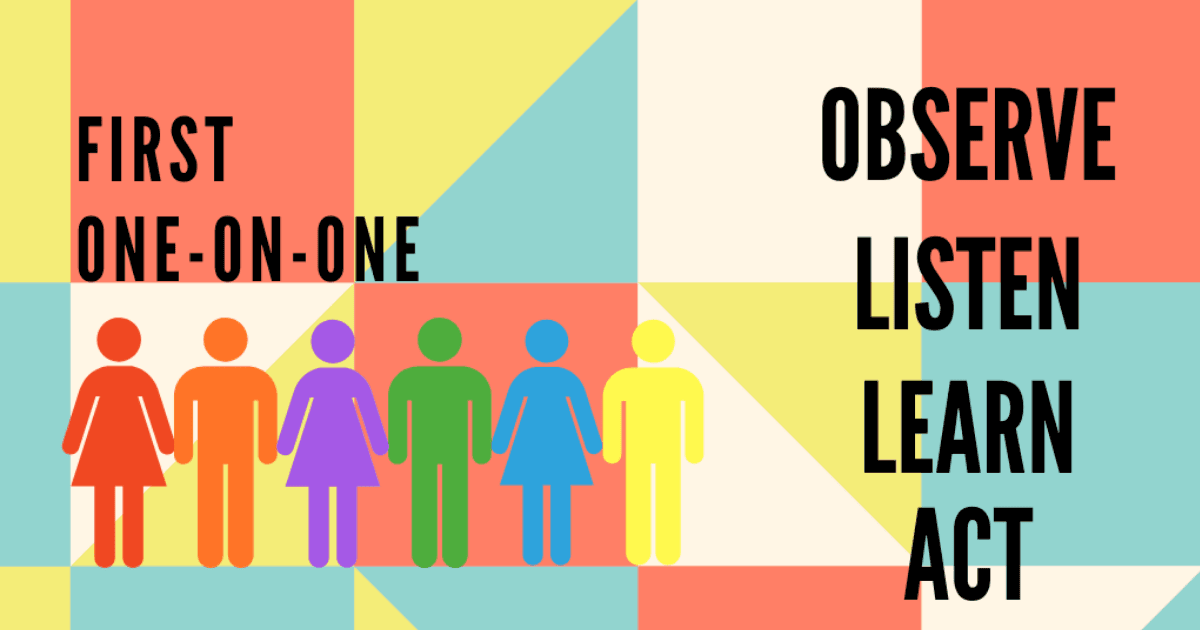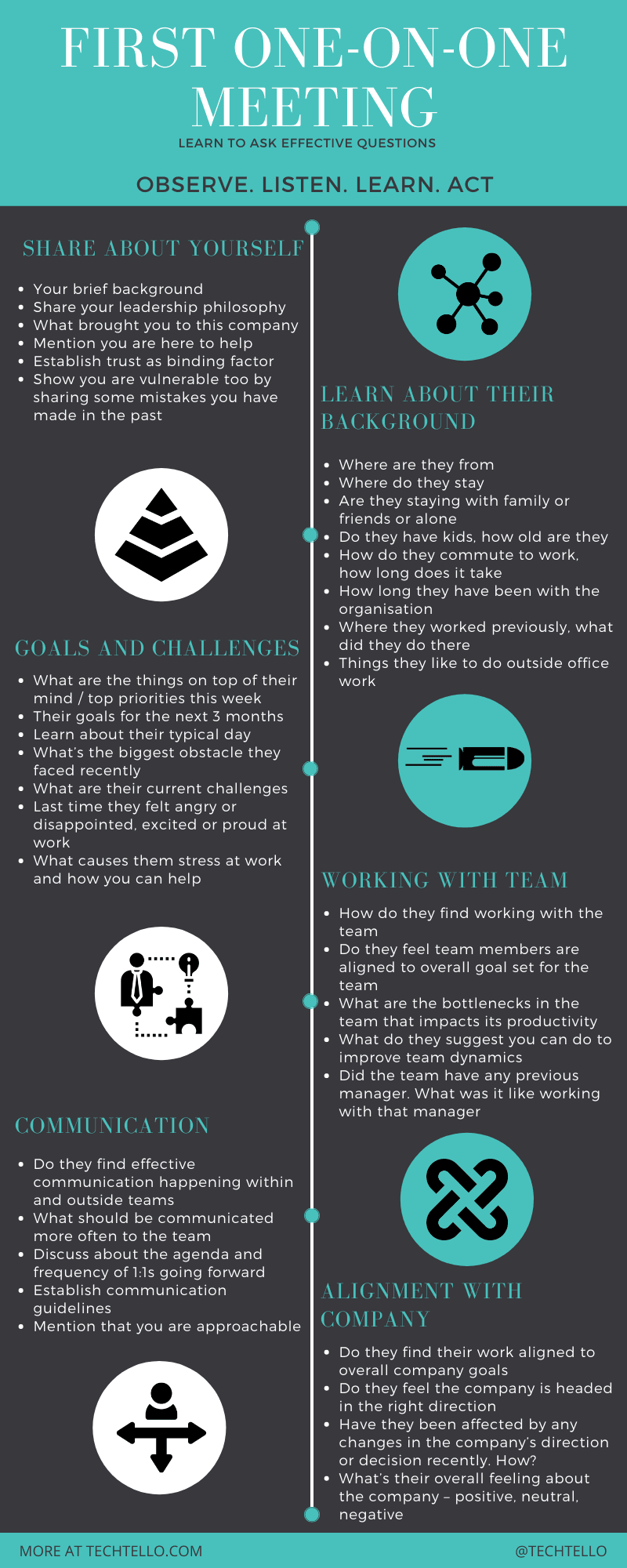First One-on-One Meeting: Build Strong Relationships

Is the first one-on-one meeting an item in your to-do list that you are waiting to strike off or do you really care about the effectiveness of the meeting?
The first one-on-one meeting with direct reports is special and exciting because it’s the beginning of a new relationship and your chance to get a peek into your direct reports life beyond work. How you communicate and what you say during the first one-on-one sets the tone of your future interactions.
Do they see you as someone who’s having this conversation out of a true desire to get to know them, curiosity to learn about each other and intent to help you grow or just another manager with selfish interests at heart who acts out of a place of fear, says things they don’t mean and pretends to care.
While trust may take a long time to build, the first few interactions shape up whether your direct reports will incline towards trust or away from it. Would you rather spend your time and energy in building trust from the beginning or doing damage control later?
What’s more important – team output or individual aspirations?
Individual focus over team output
People in the team come from different backgrounds, cultures, experiences and expectations. What makes one person excited may annoy another one. Their unique personality is an outcome of their belief system that determines what they do and how they do it.
Learning about this belief system that drives every individual is of crucial importance to maximize team output by aligning individuals to opportunities based on their core needs.
First one-on-one meeting provides the perfect opportunity to start on the right note and build a successful team that’s highly collaborative and productive by optimising for individual aspirations.
An important note for managers from Julie Zhuo in her book, The Making of a Manager
What you quickly realise as a manager is that the single most effective way to setup a team for success in the long run is to focus on the people
Do you need to act fast by making changes which are in the best interest of your team?
Being slow is being fast in the long run
The incumbent desire to make things right, improve existing systems and processes may stem from the right intention, but without trust they will not generate the expected impact.
Without establishing sufficient context on the current state of things, learning about your team members and building relationships with them, anything that you try to change may create a negative sentiment in the team.
Without trust, they may not be open to your ideas irrespective of how good and valuable they are to the team. Once you have earned their respect and established credibility by connecting with them at a personal level and showing genuine desire to make things better, it will be easier to align everyone to common goals and push for improvements.
While you still have the time, slow down, do not rush. Watch out for mistakes as a new manager and work on building trust to achieve more together.
Important guidelines for first one-on-one meeting
A well planned and structured 1-1 meeting can be highly effective in building trust and relationships. Follow these guidelines to plan your first one-on-one meeting with an employee:
- Schedule your first one-on-one meeting. Don’t make it ad hoc. It’s a reflection of being organised while also respecting other people and their time
- Talk about the importance of one-on-one meetings and how such discussions can be valuable to everyone in creating a culture of feedback
- Keep the focus of the discussion on the employee and encourage them to talk about themselves. Give them chance to do most of the talking while you are there to guide the conversation
- Take notes to remember important points. Mention this in the meeting so that the other person doesn’t find you distracted. Take time to pause and engage while taking notes.
- Listen actively. You can have a meaningful conversation only if you listen
- Dig into their response and explore by asking good follow-up questions
- Be curious and open minded to ask thoughtful questions
Dale Carnegie shares some important insights around listening in his book, How to Win Friends and Influence People
Be a good listener, encourage others to talk about themselves, become genuinely interested in other people, try honestly to see things from the other person’s point of view, and be sympathetic to the other person’s ideas and desires
The importance of starting with observation
Observing your direct reports may provide valuable information that you may otherwise not notice. It’s a way to learn about your employees from a distance.
It can be really effective to take some time to observe before scheduling a 1-1 meeting with your employee. I recommend taking 1-2 weeks to observe the following about each of your direct reports
- What role do they play in the team, not in terms of their assigned designation but in terms of their day to day work
- How do they work in a group setting, notice body language and tone
- What are the current projects demanding most of their team
- How do they interact with stakeholders or other team members and manage concerns and expectations
- How much talking vs listening do they do in a meeting
- Dynamics with their peer group while working with cross functional teams
- For someone in management position, how do they interact with their direct reports
- Do they feel safe bringing up issues or avoid conflicts
These observations provide good context about the person for structuring an effective one-on-one meeting.
One-on-One Meeting Questions + Template
Foster open communication, build trust, and strengthen relationships by providing a safe space for sharing feedback and addressing concerns.
Effective first one-on-one meeting questions

Before you begin the first one-on-one meeting with your direct report, remind yourself that your goal is not to set things up, it’s to listen and learn. You will have plenty of time after the first one-on-one to act.
When people see that you are invested in solving their most pressing issues, they will open up to you and trust you to do the right thing.
There are 6 categories with questions in each category that will get you to a good start with every individual. Remember to keep the conversation fluid and ask good follow-up questions.
1. Break the conversation barrier by starting with yourself
- Your brief background, where you worked in the past and any interesting products you built
- Share your leadership philosophy
- What brought you to this company
- Mention you are here to help, but also need to learn a lot from the team
- Establish trust as the basis for all discussions and commit to being transparent
- Show that you are vulnerable too by sharing some mistakes you have made in the past. It provides a safe environment for your employee to open up and be honest with you
2. Learn about their background
- Where are they from
- Where do they stay
- Are they staying with family or friends or alone
- Do they have any kids, how old are they
- How do they commute to work and how long does it take
- How long they have been with the organisation
- Where did they work previously and what did they do there
- Things they like to do outside office
3. How do they view goals and challenges at work
- What are the things on top of their mind / top priorities this week
- Ask about their goals for the next 3 months and how they feel about them. If the goals are not set, take an action item and inform them to do goal setting in another meeting
- Learn about their typical day. Who all are important to their day to day function and what help do they need from them
- What’s the biggest obstacle they faced recently that affected their progress
- What are their current challenges? Does it need attention from you or team members or anyone else outside team
- When was the last time they felt angry or disappointed about something at work
- When was the last time they felt excited or proud about something at work
- What causes them stress at work
4. What do they feel about the team
- How do they find working with the team? Follow-up with one thing that’s going well in the team and one thing they recommend to change
- Do they feel team members are aligned to overall goal set for the team
- What are the bottlenecks in the team that impacts its productivity e.g. process, communication, clarity
- What do they suggest you can do to improve team dynamics
- Did the team have any previous manager. What was it like working with that manager
5. Do they understand the importance of communication
- Do they find effective communication happening within and outside teams
- What should be communicated more often to the team
- Discuss about the agenda and frequency of one-on-one meetings going forward. Be clear that the purpose is to surface concerns, challenges, roadblocks, review things that need input, track progress towards goals and provide feedback. Ask if they would like anything else to be included in the agenda. It will make them think about how to make best use of their time and what support they might need from you
- Establish communication guidelines – when to use email, phone, chat or any other communication channel that the company uses
- Be approachable. Clarify that while you will meet them at the set aside frequency, they should not hesitate to come and talk to you
6. What are their views about the organisation
- Do they find their work aligned to overall company goals
- Do they feel the company is headed in the right direction
- Have they been affected by any changes in the company’s direction or decision recently. How?
- What’s their overall feeling about the company – positive, neutral, negative. This one helps connect to the overall sentiment with multiple follow-up questions
It’s also useful to get feedback about the most useful part of the conversation from your direct reports perspective. It helps you learn what they find valuable as opposed to making assumptions about it.
End the conversation by giving them a chance to express anything on their mind. You may not have all the answers right away, but can take it as a follow-up item for your next discussion.
After first one-on-one meeting
To establish credibility and trust with your direct reports, put your intention to action. Be relentless in following through on the discussion
- Setup regular cadence for 1:1s per agreed upon frequency
- Act upon the action items discussed in the one-on-one meeting. You may not have all the solutions, but keeping your reportee in the loop is the best way to show that you want to help
- Use the data collected from the discussion to identify specific needs of your team
- If you are managing managers, do a few skip level meetings to gather deeper insights on some of these areas before developing an action plan
One-on-one meeting is the first step in the right direction as you continue to build a strong relationship with every individual through other long term efforts. Remember, the four key steps for an effective first one-on-one with your team are observe, listen, learn and then act.
How do you plan your first one-on-one meeting? Please leave your thoughts in the comments below or write to me
































